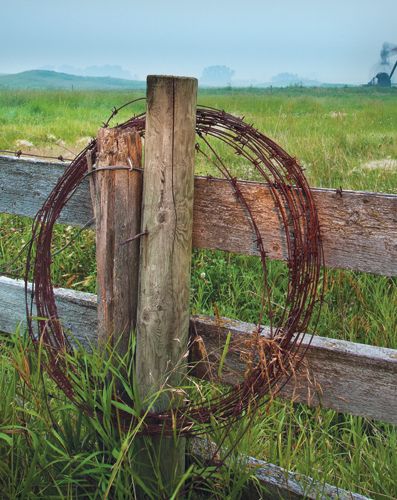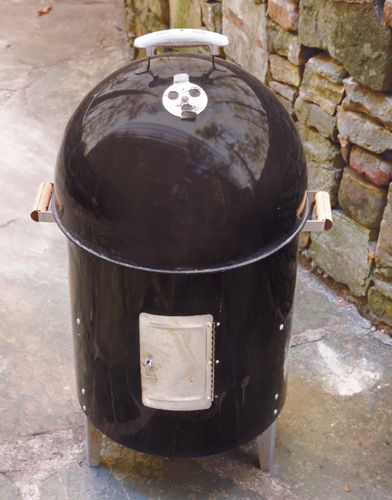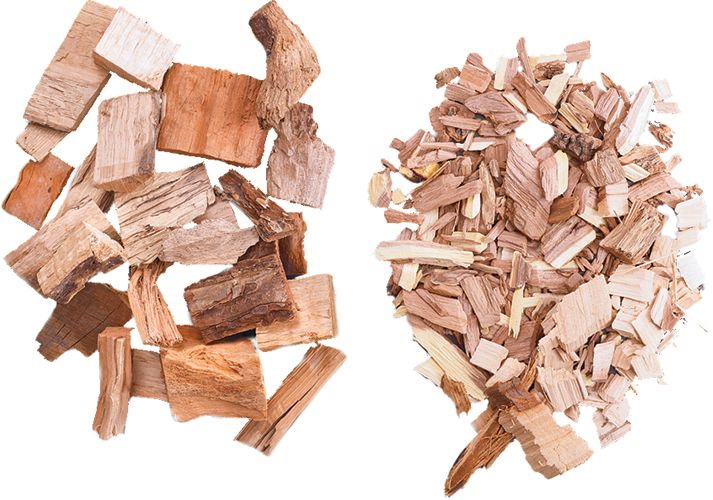Southern Living  TEXAS BBQ PLATEFULS OF LEGENDARY LONE STAR FLAVOR
TEXAS BBQ PLATEFULS OF LEGENDARY LONE STAR FLAVOR 

 CONTENTS
CONTENTS  TEXAS BARBECUES identity becomes clearer with every juicy bite. It is proud, audacious, inviting, exacting, traditional, and cutting-edge, all at once. The state itself is a mecca for those with a hankering for an exquisitely crafted brisket, cooked low and slow and dusted with a top-secret-recipe dry rub; or a steaming rack of dinosaur ribs, gargantuan enough to feed a small army; or a sizzling skillet of undeniably perfect skirt steak fajitas. The story of Texas barbecue is as mythic, wild, and vast as the Lone Star State itself. Its roots run deep, spanning continents and generations, all bringing distinct flavors into the mix. And then there are the pitmasters.
TEXAS BARBECUES identity becomes clearer with every juicy bite. It is proud, audacious, inviting, exacting, traditional, and cutting-edge, all at once. The state itself is a mecca for those with a hankering for an exquisitely crafted brisket, cooked low and slow and dusted with a top-secret-recipe dry rub; or a steaming rack of dinosaur ribs, gargantuan enough to feed a small army; or a sizzling skillet of undeniably perfect skirt steak fajitas. The story of Texas barbecue is as mythic, wild, and vast as the Lone Star State itself. Its roots run deep, spanning continents and generations, all bringing distinct flavors into the mix. And then there are the pitmasters.
This league of steely chefs who tend the glowing embers is nothing short of alchemists transmuting natures raw materials into gold. Their stagethough it may be a rusty old smokeris a gathering place for the community. After all, a whole roasted hog is meant to be shared, and anyone nearby with a functional sense of smell would be drawn to the tantalizing aroma. The genesis of Texas barbecue can be traced to the Native American, Caribbean, and Mesoamerican tribes who first cooked meat over open flames beneath a canopy of stars. These indigenous peoples knew how to bring out the best in a slab of meat, which spices would dance on the taste buds, and exactly how to translate smoke into layer upon layer of flavor. The culinary landscape shifted with the arrival of foreign explorers, conquistadors, and settlers to the New World.
With them, the French, Spanish, English, Czech, and German pioneers brought cattle and pigs, new cooking methods and technology, wheat, onions, and peaches. It was in Texas that everything collided. What was left behind (and what continues to develop decade after decade) was an edible revolutiona melding of cultures you can taste. Folks from the Deep South brought their penchant for pork ribs with thick, sweet sauce and a singular ability to chicken-fry just about anything to East Texas. The Acadians, French Catholics displaced from Canada, met with African-Americans migrating westward and created spicy Cajun dishes, like gumbo with andouille sausage. Along the Gulf of Mexico, coastal Texans took to the sea for their bounty, harvesting the briny oyster beds of Galveston Bay and chasing schools of shrimp from Brownsville through the Gulf Intracoastal Waterway.
In Central Texas, where Lockhart is considered the states barbecue capital, dry rubs supplant sauce and brisket is king. The German and Czech settlers made their home in the hills of West Texas and introduced the state to kolache, bratwurst, and mutton. Tex-Mex cuisine arrived in South Texas, where the state borders Mexico and New Mexico. Here, the Mexican people showed cowhands how to prepare barbacoa, salsa, and corn tortillas. Today, barbecue is in high demand, and Texas cue, with its panoply of techniques, tastes, and traditions, is experiencing a significant boom. Mom-and-pop bbq joints are being rediscovered by budding young pitmasters and curious epicureans.
Barbecue is definitely having its moment in the spotlight, but lets be clearbarbecues future does not rely on its current popularity. Barbecue, to those who know it best, is a living, breathing organism. It has a language, a family tree, and a culture all its own. It grew up long before any of us were here, and it will continue evolving long after were gone. Just dig in and be glad youre along for the ride. ALL THAT GRILLS IS GOLD Before you start cooking, decide which grill or smoker works best for you.
Gas Grills  Gas grills maintain consistent heat and are very easy to use; they are especially handy for beginners. Everyone has different needs to consider when buying a gas grill. Every grill is different and some come with more bells and whistles than others. If you like to grill out for the whole neighborhood or have a large household, youll want to opt for a larger model with 4 to 5 burners. If youre just starting out and like to grill a couple times a week, opt for a smaller version with 3 to 4 burners. Before turning the grill on, make sure that the propane or gas valve is open.
Gas grills maintain consistent heat and are very easy to use; they are especially handy for beginners. Everyone has different needs to consider when buying a gas grill. Every grill is different and some come with more bells and whistles than others. If you like to grill out for the whole neighborhood or have a large household, youll want to opt for a larger model with 4 to 5 burners. If youre just starting out and like to grill a couple times a week, opt for a smaller version with 3 to 4 burners. Before turning the grill on, make sure that the propane or gas valve is open.
Then turn the knob, andvoilits lit. To properly heat the grill, turn all the burners to high, close the lid, and let the grill preheat for 10 to 15 minutes. Charcoal Grills  Charcoal grills are less expensive than gas grills. While they are typically more hands-on, these grills have another advantage over gas grills in that they impart a characteristic smoky flavor. If youve got one of these grills, use a chimney starter to help with lighting the coals. It will take about 15 to 30 minutes to get the coals lit, depending on the type of charcoal you use.
Charcoal grills are less expensive than gas grills. While they are typically more hands-on, these grills have another advantage over gas grills in that they impart a characteristic smoky flavor. If youve got one of these grills, use a chimney starter to help with lighting the coals. It will take about 15 to 30 minutes to get the coals lit, depending on the type of charcoal you use.
Once the coals are lit, pour the coals into the bottom of the grill (below the grill grate), replace the grill grate, and close the lid. Be sure that the air vents in the top and bottom are open. To increase the heat of the fire, open the vents wide. To decrease the heat, partially close the vents. Dont close the vents all the way unless you want the fire to go out. Smokers  Water smokers (pictured) are probably the most common type of smoker since they are relatively inexpensive and fairly easy to operate.
Water smokers (pictured) are probably the most common type of smoker since they are relatively inexpensive and fairly easy to operate.
Most are bullet-shaped and come with a water pan. The water in the water pan acts as a temperature regulator and also often keeps meats that cook for a long period of time more moist. This type of smoker can consistently remain between the 200F and 250F range for up to 4 hours, and often longer, depending on what type of coals are used. This equipment creates an indirect cooking environment. The coals and wood are in the bottom section, the water pan in the middle, and the food is in the top where the vents are also located. Offset smokers (not shown) are also readily available.
This design has the charcoal and wood burning off to the side of the main cooking barrel with a vent for lowering or raising the heat. The location of the fuel chamber helps maintain an even temperature for the main cooking barrel. There is also a baffle on top to help control the amount of air that comes in, which in turn helps regulate the amount of smoke. Tip Resist the temptation to lift the lid during smoking to check meat before the recommended cooking time has elapsed. Doing so allows heat and moisture to escape and adds to the cooking time. INTO THE WOODS Another thing that makes authentic Southern barbecue great is the massive amount of flavor you can impart from the type of wood you use in smoking recipes.
From peach and apple to mesquite and hickory, there are many different options available. Wood Chips 
Next page





 TEXAS BBQ PLATEFULS OF LEGENDARY LONE STAR FLAVOR
TEXAS BBQ PLATEFULS OF LEGENDARY LONE STAR FLAVOR 

 CONTENTS
CONTENTS  TEXAS BARBECUES identity becomes clearer with every juicy bite. It is proud, audacious, inviting, exacting, traditional, and cutting-edge, all at once. The state itself is a mecca for those with a hankering for an exquisitely crafted brisket, cooked low and slow and dusted with a top-secret-recipe dry rub; or a steaming rack of dinosaur ribs, gargantuan enough to feed a small army; or a sizzling skillet of undeniably perfect skirt steak fajitas. The story of Texas barbecue is as mythic, wild, and vast as the Lone Star State itself. Its roots run deep, spanning continents and generations, all bringing distinct flavors into the mix. And then there are the pitmasters.
TEXAS BARBECUES identity becomes clearer with every juicy bite. It is proud, audacious, inviting, exacting, traditional, and cutting-edge, all at once. The state itself is a mecca for those with a hankering for an exquisitely crafted brisket, cooked low and slow and dusted with a top-secret-recipe dry rub; or a steaming rack of dinosaur ribs, gargantuan enough to feed a small army; or a sizzling skillet of undeniably perfect skirt steak fajitas. The story of Texas barbecue is as mythic, wild, and vast as the Lone Star State itself. Its roots run deep, spanning continents and generations, all bringing distinct flavors into the mix. And then there are the pitmasters. Gas grills maintain consistent heat and are very easy to use; they are especially handy for beginners. Everyone has different needs to consider when buying a gas grill. Every grill is different and some come with more bells and whistles than others. If you like to grill out for the whole neighborhood or have a large household, youll want to opt for a larger model with 4 to 5 burners. If youre just starting out and like to grill a couple times a week, opt for a smaller version with 3 to 4 burners. Before turning the grill on, make sure that the propane or gas valve is open.
Gas grills maintain consistent heat and are very easy to use; they are especially handy for beginners. Everyone has different needs to consider when buying a gas grill. Every grill is different and some come with more bells and whistles than others. If you like to grill out for the whole neighborhood or have a large household, youll want to opt for a larger model with 4 to 5 burners. If youre just starting out and like to grill a couple times a week, opt for a smaller version with 3 to 4 burners. Before turning the grill on, make sure that the propane or gas valve is open. Charcoal grills are less expensive than gas grills. While they are typically more hands-on, these grills have another advantage over gas grills in that they impart a characteristic smoky flavor. If youve got one of these grills, use a chimney starter to help with lighting the coals. It will take about 15 to 30 minutes to get the coals lit, depending on the type of charcoal you use.
Charcoal grills are less expensive than gas grills. While they are typically more hands-on, these grills have another advantage over gas grills in that they impart a characteristic smoky flavor. If youve got one of these grills, use a chimney starter to help with lighting the coals. It will take about 15 to 30 minutes to get the coals lit, depending on the type of charcoal you use. Water smokers (pictured) are probably the most common type of smoker since they are relatively inexpensive and fairly easy to operate.
Water smokers (pictured) are probably the most common type of smoker since they are relatively inexpensive and fairly easy to operate.